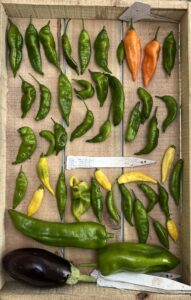Sow sweet peas in a cool greenhouse for an early display next year. Soften the seed coat, by putting the seeds between two layers of kitchen towel on a dinner plate. Dampen the towel, drain off excess water, sow those that start to swell or sprout, usually after about 48 hours. Leave any others a little longer; any that don’t respond can be composted. Sow the germinated seeds individually into ‘Root Trainers’ or 9cm (3in) pots of seed compost or five to seven seeds to a 13cm (5in) pot, each seed spaced 2-3cm (¾-1¼in) apart, then cover them with 1cm (½in) of compost. Water in gently, cover the pots with clear polythene then put them in a propagator at about 15°C (59°F). Remove the covering after they have germinated and overwinter the young plants in a cold frame or unheated greenhouse. If not sown individually, transplant seedlings singly seedlings into 9cm (3in) pots once they have reached about 3.5 cm (1½in) tall.
Continue to sow batches of winter salads weekly in an unheated greenhouse. When it is warm and sunny, sow trays, pots, old growing bags or borders with ‘cut and come again crops’ to harvest through autumn and into winter. Try land cress, pak choi, mizuna and mibuna greens plus lettuce, like ‘Salad Bowl’, lamb’s lettuce, chicory and radish, plus what is left in the packets from earlier brassica sowings which can be harvested earlier as microgreens.
Ventilate the glasshouse as temperatures rise on dry days but avoid cold draughts and keep them closed if it is raining or foggy. High humidity and poor air circulation encourages botrytis or grey mould, which spreads rapidly in damp conditions and is grey-brown and fuzzy. Remove infected material, ventilate the greenhouse whenever possible or use a glasshouse fan heater to circulate the air on days when the windows aren’t opened.
‘Lily of the Valley’ (Convallaria majalis) can be dug up, potted and forced in the greenhouse from November. Rhizomes that are kept in a frost-free greenhouse over winter stay in active growth and given a little heat, will be ready to flower shortly after replanting in the garden next spring.
Cuttings of tender plants taken in September and annual seedlings sown earlier in the year, can now be transplanted into pots one or two sizes larger. I have twenty cuttings of different Salvias in a large tray that will be potted on into 3” pots of peat free multipurpose compost and kept slightly moist over winter and protected with a layer of horticultural fleece. The roots of plants with dry rootballs is less likely to freeze than those which are moist, so err on the dry side.

Make your final harvest of glasshouse crops like peppers, chillies and aubergines. Chillies can be eaten fresh or dried in a warm oven on a baking tray for later use.
Pot up chives, mint and parsley into peat free multipurpose compost and bring them into the greenhouse. Kept moist, they will continue to grow over winter.
Alpine cushion plants in pots can be brought into an unheated greenhouse and the compost kept dry, this prevents rotting by winter wet. Happy Gardening, Matt.


